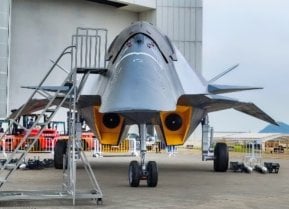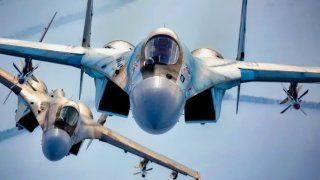The Russian Air Force Is Becoming 'Flying Artillery' in Ukraine War
In over 1,000 days of war, the Russian Aerospace Forces have achieved little. The skies are still contested despite Moscow having a numerical superiority and better aircraft, that is changing with the arrival of F-16s for Ukraine. As a result, Russian aircraft are mainly using long-range munitions to attack Ukrainian targets.
What You Need to Know: After over 1,000 days of conflict, the Russian Aerospace Forces have failed to secure air superiority in Ukraine despite numerical and technological advantages. Russia's air strategy has shifted to using aircraft like the Su-34 for "airborne artillery" roles and relying heavily on UAVs for attacks.

-International sanctions have crippled Russia’s ability to produce advanced weaponry, forcing them to cannibalize household electronics for semiconductors. Ukraine's advanced air defenses, bolstered by Western systems like Patriot and NASAMS, have mitigated some Russian aerial threats.
-Meanwhile, Ukrainian drone strikes on Russian strategic sites have caused significant losses, highlighting Russia's inability to defend its critical military infrastructure.
The Russian Air Force in Ukraine
In over 1,000 days of war, the Russian Aerospace Forces have achieved little. The skies are still contested despite Moscow having a numerical superiority and better aircraft, that is changing with the arrival of F-16s for Ukraine. As a result, Russian aircraft are mainly using long-range munitions to attack Ukrainian targets.
The Air War After 1,000 Days
“Over 1,000 days into the conflict, Russia’s Aerospace Forces, despite technological and numerical advantage, have failed to gain air superiority over Ukraine,” the British Military Intelligence assessed in its latest estimate of the conflict.
In many ways, the Russian military has stopped using its airpower effectively, delegating it to inefficient roles that don’t stand a chance of impacting the fighting.
“Russia has resorted to using their tactical level aviation, such as SU-34 aircraft, as airborne artillery,” the British Military Intelligence added.
“The major development that has changed the nature of the conflict has been the use of Uncrewed Aerial Vehicles (UAVs). Since mid-2024, the number of One Way Attack UAV launches has likely allowed Russia the space and time to recuperate its Long Range Aviation fleet, and their associated Air Launched Cruise Missile and Air-Launched Ballistic Missile stocks,” the British Military Intelligence stated.
The international sanctions on Russia have seriously affected the country’s defense and aerospace industries and their ability to produce munitions of high quality. For example, Russia has trouble getting semiconductors to power its advanced weapon systems and munitions. The shortage is so significant that it has forced the Russian military to take dire measures such as cannibalizing household goods, like televisions, refrigerators, and microwaves, to scavenge semiconductors for weapons.
“While retains the ability to use these assets, the ultimate effect is that the Air Defense picture for Ukraine is increasingly busy, complex, and challenging. With the combination of systems, the Russians have targeted Ukrainian critical infrastructure (CNI) and air bases. Future strikes against Ukrainian CNI are expected this winter, as Russia attempts to break the will of the Ukrainian people,” the British Military Intelligence stated.

The Russian military has fired thousands of ballistic and cruise missiles and suicide drones against Ukrainian urban centers and critical infrastructure. The attacks have killed and wounded hundreds of innocent civilians, while also limiting access to basic goods such as water and heat.
The United States and its allies have provided significant air defense capabilities to Ukraine, including MIM-104 Patriot, IRIS-T, and NASAMS air defense batteries. These weapon systems have bolstered Ukrainian air defense capabilities, making it harder for incoming Russian munitions to cause damage. Nonetheless, the Russian military still retains advanced munitions that can penetrate Ukrainian air defense and wreak havoc.
To counter the Russian aerial attacks and generally deplete the capabilities of the Russian military and its ability to wage an offensive war inside Ukraine, the Ukrainians have been using suicide drones against targets inside Russia.
“Ukraine has successfully used UAVs against military targets in Russia. In mid and late September, Ukraine struck four Russian strategic ammunition depots hundreds of kilometers from Ukraine,” the British Military Intelligence stated.
The total amount of ammunition destroyed in these attacks marks the highest loss of Russian ammunition in the entire war.
“The attacks again highlight Russia’s inability to protect strategic military sites from Ukrainian UAV attack,” the British Military Intelligence concluded.
About the Author:
Stavros Atlamazoglou is a seasoned defense journalist specializing in special operations and a Hellenic Army veteran (national service with the 575th Marine Battalion and Army HQ). He holds a BA from Johns Hopkins University and an MA from the Johns Hopkins School of Advanced International Studies (SAIS). His work has been featured in Business Insider, Sandboxx, and SOFREP.
Image Credit: Creative Commons and/or Shutterstock.


